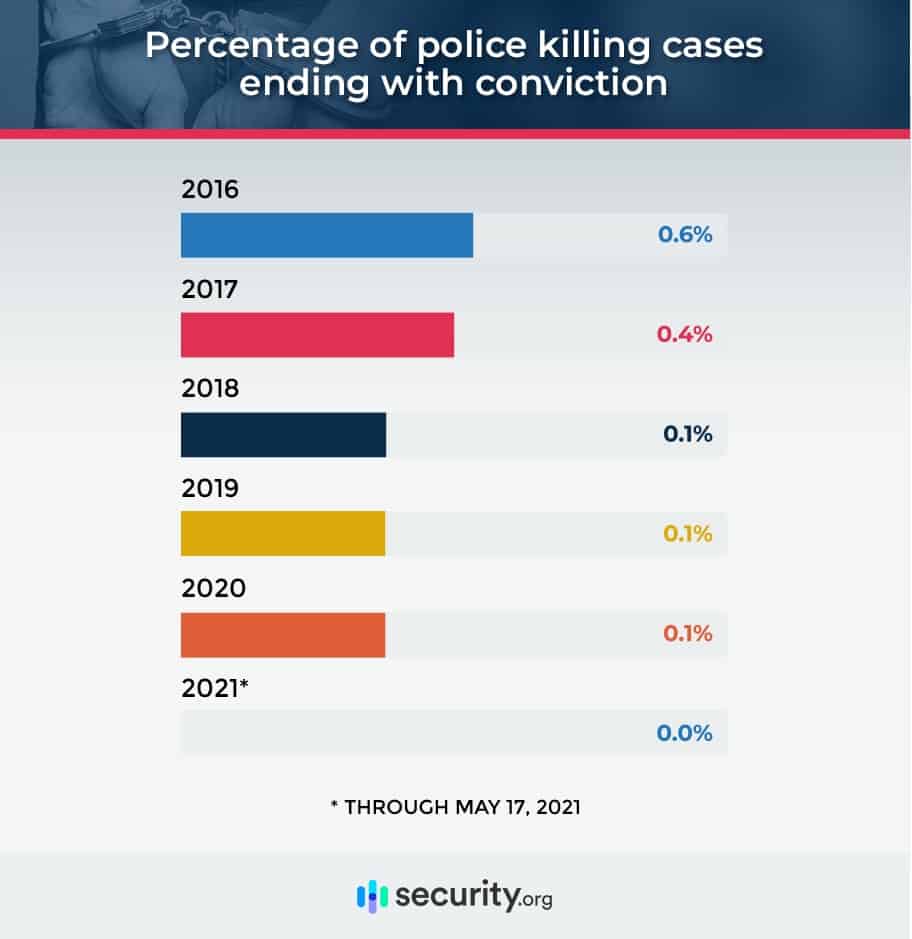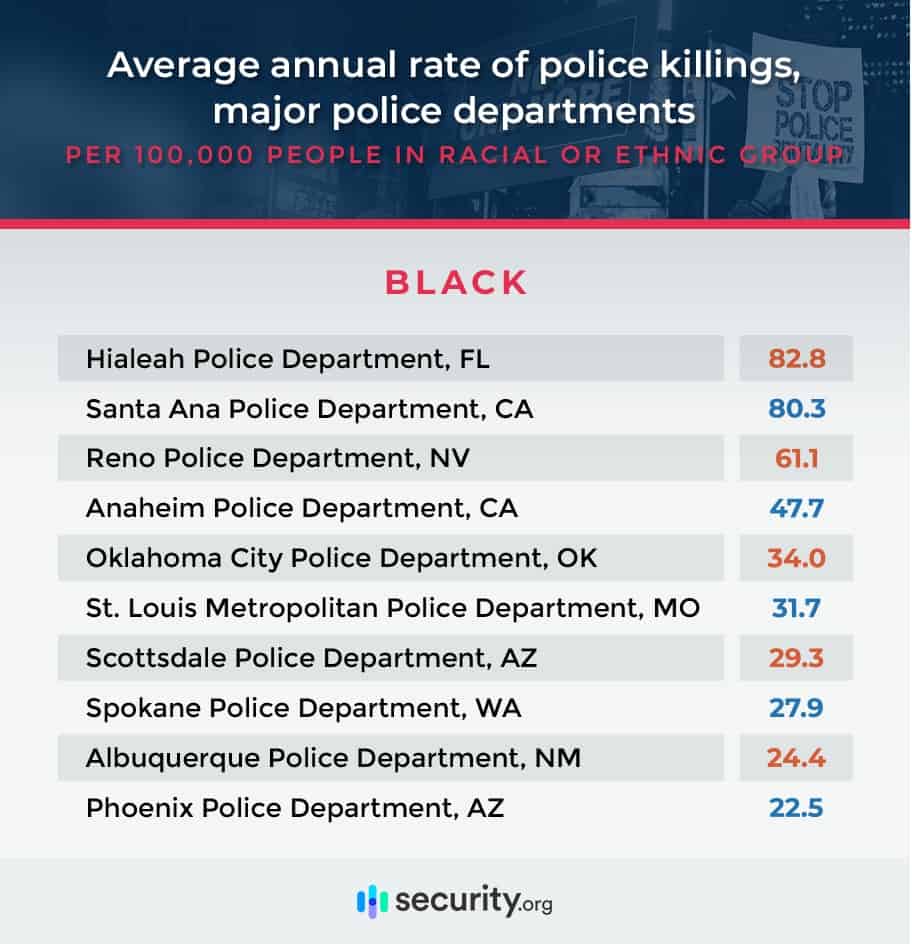Police Brutality Statistics & Analysis for Cities and States
Police brutality is neither new nor rare. We’ve all heard about it in the news. But did you know that the FBI didn’t even begin gathering data on the use of force by police officers until 2019? And the only use-of-force data the FBI covers is the percentage of agencies that send data, not the actual use of force by police across the country.
We’re here to bridge the gap. Since there is no publicly released set of government statistics related to police violence, we turned to a team of researchers who collect and analyze data on police killings, called Mapping Police
What is the state of police violence across the U.S.? How common are police killings, and which cities are most likely to experience police killings? Read on for our analysis of police-violence statistics.
The State of Police Violence
Looking at the most recent data from Mapping Police Violence, police in the U.S. killed 1,270 people in 2024 alone, marking it as the deadliest year on record since tracking began. This averages out to approximately 3.5 people killed by police every single
In 2024, shootings remained overwhelmingly the most common cause of death in police encounters, with gunshots accounting for 96 percent of all police killings. The remaining deaths resulted from tasers, vehicles, physical restraint and other causes.
Criminal prosecution for police violence remains extraordinarily uncommon. According to recent data, less than one percent of police killings result in officers being charged with a crime, and convictions are even rarer.
Former Minneapolis police officer Derek Chauvin’s conviction for the murder of George Floyd marked a watershed moment in police accountability, though it remains an outlier. Since then, several high-profile cases have resulted in convictions. That includes former officer Kim Potter for killing Daunte Wright and former officer Mohamed Noor for killing Justine Damond, both in Minnesota.
Even with Chauvin’s conviction, some believe that the only reason he was charged, tried, and convicted of Floyd’s murder was that a bystander recorded the incident. Video evidence has become increasingly crucial in police accountability cases, with body cameras and civilian recordings playing pivotal roles in recent prosecutions.
Even when an officer is on trial, prosecutors may face uphill battles to convict, said civil rights lawyer David Rudovsky.
“There is a tendency to believe an officer over a civilian, in terms of credibility,” Rudovsky told Vox.2 “And when an officer is on trial, reasonable doubt has a lot of bite. A prosecutor needs a very strong case before a jury will say that somebody we generally trust to protect us has so seriously crossed the line as to be subject to a conviction.”
Cities Where Police Killings Are Most Common
Breaking it down by city, Los Angeles continues to lead the nation in total police killings, with 125 people killed by police from 2017 through 2025. Phoenix follows with 120 deaths, while Houston recorded 96 police killings during the same period.
Los Angeles has a particularly grim history when it comes to police violence. The acquittal of five white police officers in the brutal beating of Black motorist Rodney King sparked days of civil unrest in the city. This was fueled in part by the fact that a bystander caught the entire attack on camera.
But decades before the 1992 riots, the city’s predominantly Black neighborhood, Watts, was the site of a five-day skirmish between police and civilians.
Police killings remain disturbingly common in LA. A comprehensive analysis by the Los Angeles Times found that since 2000, LA County law enforcement has killed more than 1,000 people. Despite this staggering number, prosecutors have charged officers in fewer than 2% of these
Phoenix’s police killings have also drawn intense scrutiny. The city saw 14 police killings in 2024 alone, maintaining its position among the deadliest police departments in America despite ongoing reform efforts and the Department of Justice
Other cities have seen police killings increase dramatically. Among cities with police killings in both 2016 and 2020, the number of fatal law enforcement incidents in Detroit surged by 500 percent.
When we adjust for population size, the picture shifts dramatically. St. Louis, Missouri had the highest rate of police killings among major cities at 1.53 per 100,000 residents, followed by Albuquerque at 1.08 per 100,000.
According to recent analyses, officers in many of these high-rate departments frequently resort to lethal force without attempting de-escalation techniques first. Some departments show non-lethal alternatives were not attempted in over 70 percent of fatal
Los Angeles, which had the highest number of killings over the past five years, had one of the lowest population-adjusted rates, while Phoenix had one of the highest.
Racial Disparities in Police Violence
At the heart of the Black Lives Matter movement and the protests after the murder of George Floyd were discrepancies between the rate at which police kill white people and the rate at which they kill Black people, Native Americans, and Hispanic people.
Black Americans make up about 13 percent of the U.S. population, yet they account for more than one in four people killed by police. This means Black people are killed by police at 2.8 times the rate of white people. Native Americans face similar disparities, being killed at 2.7 times the rate of white people, while Hispanic people are killed at 1.3 times the rate.
While the overall U.S. homicide rate hovers around 6.5 per 100,000 people3, the rate at which police kill Black Americans exceeds this in many major cities. That effectively makes police encounters a leading cause of death for young Black men.
Phoenix police most consistently have high population-adjusted rates of killings of Black, Hispanic, and Native American people. In fact, the department appears in the top 10 for the rate at which police killed individuals in all three groups. Police in Albuquerque, Denver, Mesa, Oklahoma City, Reno, Spokane, and St. Louis all appear in the top 10 for these two racial groups.
Zooming out to the state level, in almost all states, the rate at which police kill Black people is far higher than the rate at which they kill white people. In some cases, the differences in fatal encounters with police in the U.S. are startling.
In Utah, for example, police have killed Black people at a rate of 26.7 per 100,000, compared with 2.7 per 100,000 for white people. West Virginia, Oklahoma, and Alaska all have disparities in the double digits.
Colorado, Idaho, North Dakota, Nebraska, South Dakota, and Washington all have disparities between the rates of killings of Native Americans and white people, though fewer states had qualifying incidents. To avoid skewing data too heavily, we excluded states that had only one police killing of someone in the ethnic group.
No state had double-digit disparities between Hispanic people and white people.
Conclusion
The data paints a clear picture: police violence remains a persistent crisis in American communities. Unfortunately, there’s little sign of meaningful reduction despite years of protests and calls for reform. The numbers tell us that accountability remains elusive, with prosecutions rare and convictions even rarer.
When police kill a civilian, the initial assumption by some is that the incident was justified, while others automatically assume it wasn’t. While the truth may be somewhere in between, the public can’t possibly make informed decisions without cold, hard facts.
And the facts undeniably show several things:
- Police kill more than 1,100 civilians every year, with 2024 setting a new record.
- In almost every corner of the country, police kill Black, Native American, and Hispanic people at higher rates than white people.
- Officers face criminal charges in fewer than one percent of killings and are convicted in less than 0.3 percent of cases.
References
- https://mappingpoliceviolence.org/
- https://www.vox.com/21497089/derek-chauvin-george-floyd-trial-police-prosecutions-black-lives-matter
- https://www.latimes.com/projects/los-angeles-police-killings-database/
- https://www.phoenixnewtimes.com/news/people-killed-by-phoenix-police-2025-21297528/
- https://policescorecard.org/ca/police-department/san-bernardino












